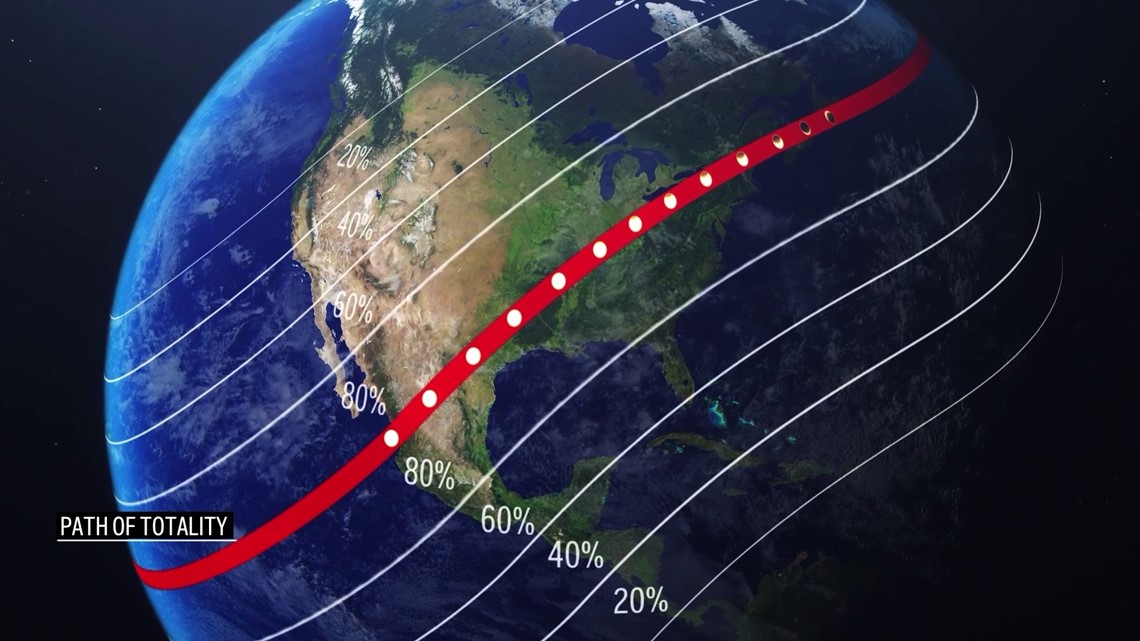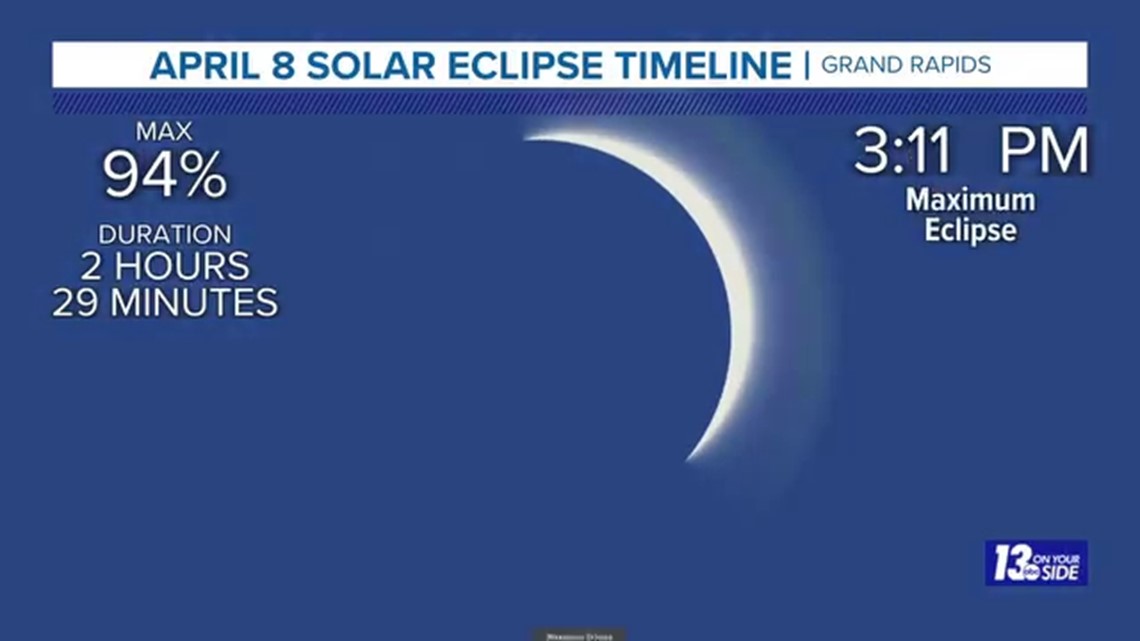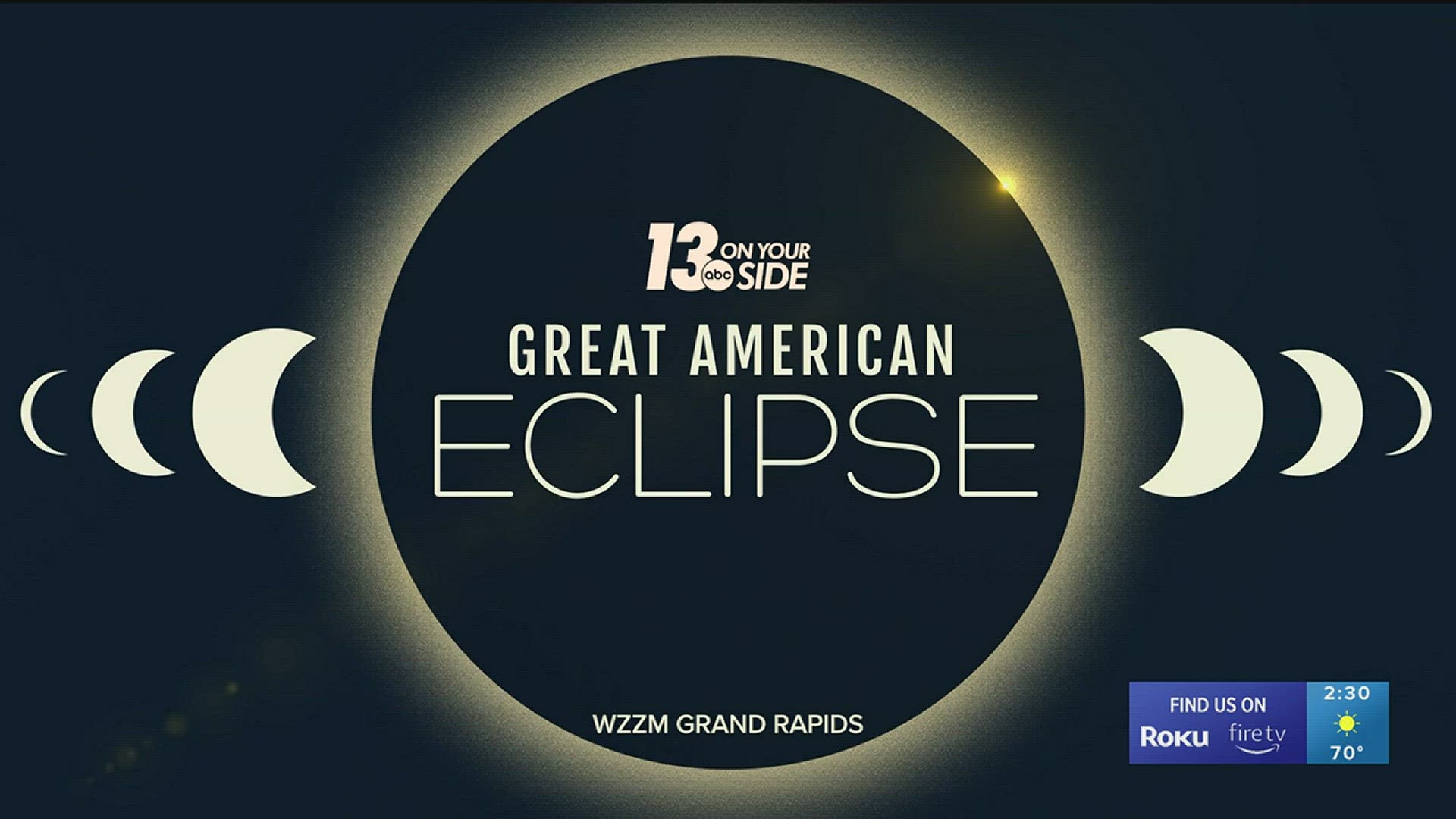GRAND RAPIDS, Mich. — For the first time in seven years, a total solar eclipse will be visible in the United States. Millions of people will be plunged into darkness in the middle of the afternoon as the moon covers the sun.
Most of Michigan won't be seeing a total solar eclipse, but the entire state will be experiencing at least a partial eclipse.
Watch special coverage of the Great American Eclipse starting at 2:30 p.m. on Monday, April 8 through 3:30 p.m.
13 ON YOUR SIDE Chief Meteorologist George Lessens is traveling to Arkansas to experience totality. Meteorologist Samantha Jacques will be in Indiana to see the solar eclipse, while Meteorologist Blake Hansen will watch from the Muskegon Astronomical Society.
You can watch our live coverage on 13 ON YOUR SIDE, on our website, news app, and 13+.
Download our streaming app for free on Roku, Amazon Fire TV and Apple TV.
Here's what you need to know.
What is a solar eclipse? What can I expect?
The total solar eclipse will move over parts of Mexico, the United States and Canada on Monday, April 8. As the moon orbits the earth, it will temporarily block the sun from our view, causing a total solar eclipse in areas in the moon’s shadow, also called the path of totality.
While only a small portion of the U.S. will be in the path of totality, a partial eclipse will be visible for all 48 contiguous states.
All of Michigan will see a partial solar eclipse except for three cities in the path of totality: Luna Port, Ottawa and Vienna.


When will the eclipse happen?
The solar eclipse starts the afternoon of Monday, April 8 for Michiganders. The peak of the eclipse will be around 3:11 p.m. in Grand Rapids. Here's a full timeline of the eclipse in our area:
- 1:55 pm - First Contact - the partial eclipse begins when the edge of the Moon touches the edge of the sun.
- 2:17 pm - 20% Coverage - about one-fifth of the Sun's disk is covered by the Moon.
- 2:25 pm - Temperature Changes - the amount of solar energy decreases so temperatures may begin to cool slightly.
- 2:40 pm - Sky Darkens - as the eclipse progresses, the sky begins to darken.
- 2:48 pm - Weather Changes - conditions continue to change.
- 2:55 pm - Colors Fade - surroundings start to darken; colors turn grayish.
- 3:04 pm - Nature Reacts - animal and plant behavior affected.
- 3:11 pm - Maximum Eclipse
- 3:17 pm - Nature Returns - animals and plants are returning to normal.
- 2:34 pm - Sky Brightens - the sky and surroundings returning to normal.
- 3:30 pm - 20% Coverage - about one-fifth of the Sun's disk is covered by the Moon.
- 3:24 pm - Last Contact - the partial eclipse ends when the edge of the Moon leaves the edge of the sun.
What will the eclipse look like in Michigan?
The level of totality seen by Michiganders varies widely based on location.
In southeastern Michigan, three cities – Ottawa, Vienna and Luna Port – will see totality for about 30 seconds. Other cities in the area will be just outside the path of totality, with some seeing 99.98% totality.
West Michigan will only see about 94% totality. While this is enough to darken the sky as if it’s evening, it won’t be enough to see stars or cover the sun entirely. Shadows will also appear as crescent moon shapes.
The further south and east you travel, the higher the percentage of totality will become.


When did Michigan last see a total solar eclipse?
In the U.S., a total solar eclipse was last seen in August 2017. For Michigan, it goes much farther back since totality was seen in the state – 1954!
The 1954 total solar eclipse only clipped a portion of the state in the Upper Peninsula, leaving the rest of the state seeing a partial eclipse with a high percentage of coverage.
Michigan won’t have a total solar eclipse come through the state again until Sept. 14, 2099, when the path of totality crosses right over Grand Rapids. Only 75 years to go!
The next total solar eclipse to cross through the U.S. won't be until August 2044, and will largely be visible in Canada, Montana and parts of South Dakota and North Dakota.
What can I do to celebrate the eclipse?
Libraries, museums and other organizations are hosting educational events, hands-on workshops and expert seminars leading up to the total solar eclipse. Many of these events are family-friendly. You can find our full list of events here.
There are also a variety of viewing parties happening during the eclipse, and there will likely be a gathering near you. Most are being hosted by libraries and museums, but some are hosted by residents. Find a watch party near you here.
Where can I get solar eclipse glasses?
While the solar eclipse will cause the sky to darken, looking at a partial solar eclipse is still very damaging to your eyes. The only time experts say you can look at a solar eclipse without eye protection is during totality.
If you haven’t gotten your eclipse glasses yet, you’re in luck!
According to a list by the American Astronomical Society, many large retail chains such as Meijer, Lowe's or Walmart are selling the glasses. However, it's recommended to buy them in stores versus online and to double-check the safety credentials before purchasing.
It's also recommended to check the retailer's website before heading to the store to make sure the glasses are still in stock near you.
If you're attending a watch party, many organizations will be handing out glasses for free. Check our watch party list for more information.
How can I watch the eclipse?
As long as you have solar eclipse glasses, you can step outside on the afternoon of April 8 and watch as the moon begins to block the sun.
If you can't get your hands on safe glasses, there are ways you can make your own solar eclipse viewer at home, including a pinhole projector and an eclipse viewer made with a shoebox. Details on how to make those can be found here.
If you aren't able to go outside or safely view the eclipse in person, 13 ON YOUR SIDE will have special coverage both on-air and online from West Michigan and areas in the path of totality.
Still have questions?
You can text "eclipse" to 616-559-1310 to share your lingering questions about the total solar eclipse, and we'll do our best to get answers.
►Make it easy to keep up to date with more stories like this. Download the 13 ON YOUR SIDE app now.
Have a news tip? Email news@13onyourside.com, visit our Facebook page or Twitter. Subscribe to our YouTube channel.
Watch 13 ON YOUR SIDE for free on Roku, Amazon Fire TV Stick, and on your phone.

